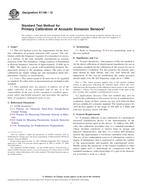We need your consent to use the individual data so that you can see information about your interests, among other things. Click "OK" to give your consent.
ASTM E2191/E2191M-10
Standard Practice for Examination of Gas-Filled Filament-Wound Composite Pressure Vessels Using Acoustic Emission
STANDARD published on 1.6.2010
The information about the standard:
Designation standards: ASTM E2191/E2191M-10
Note: WITHDRAWN
Publication date standards: 1.6.2010
SKU: NS-44608
The number of pages: 8
Approximate weight : 24 g (0.05 lbs)
Country: American technical standard
Category: Technical standards ASTM
The category - similar standards:
Acoustic measurements and noise abatement in generalPressure vessels, gas cylinders
Annotation of standard text ASTM E2191/E2191M-10 :
Keywords:
acoustic emission, composite gas cylinders, composite pressure vessel, flaws, gas pressure vessels, NGV tanks, Acoustic emission (AE) testing--metals/metallic materials, Composite pressure vessels, Filament-wound pressure vessels, Gas cylinders, Gas pressure systems/applications, Industrial metals/alloys, Pressure vessels, ICS Number Code 17.140.01 (Acoustic measurements and noise abatement in general), 23.020.300
Additional information
| Significance and Use | ||||||||||||||||||||||
|
Due to safety considerations, the Compressed Gas Association (CGA) and others have produced guidelines which address in-service inspection of NGV fuel containers (see 2.2-2.4). AE examination is listed as an alternative to the minimum three-year visual examination which generally requires that the container be removed from the vehicle to expose the entire container surface. The AE method allows “in-situ” examination of the container. Slow-fill pressurization must proceed at flow rates that do not produce background noise from flow of the pressurizing medium. Acoustic emission data are recorded throughout a pressurization range (that is, 50 % to 100 % of AE examination pressure). Fast-fill pressurization can be used if hold periods are provided. Acoustic emission data are recorded only during the hold periods. Note 1—Fast-fill pressurization is less appropriate for carbon (or graphite) composites due to the lower sensitivity of carbon fibers to stress rupture compared to other fibers. Background noise above the threshold will contaminate the AE data and render them useless. Users must be aware of the following common causes of background noise: high fill rate (measurable flow noise); mechanical contact with the vessel by objects; electromagnetic interference (EMI) and radio frequency interference (RFI) from nearby broadcasting facilities and from other sources; leaks at pipe or hose connections and airborne particles, insects, rain and snow. This practice should not be used if background noise cannot be eliminated or controlled. 5.2 Sensitivity is influenced by factors that affect elastic wave propagation, sensor coupling and signal processor settings. 5.3 It is possible to measure AE from AE sources that cannot be verified by other NDE methods. |
||||||||||||||||||||||
| 1. Scope | ||||||||||||||||||||||
|
1.1 This practice provides guidelines for acoustic emission (AE) examination of filament-wound composite pressure vessels, for example, the type used for fuel tanks in vehicles which use natural gas fuel. 1.2 This practice requires pressurization to a level equal to or greater than what is encountered in normal use. The tanks' pressurization history must be known in order to use this practice. Pressurization medium may be gas or liquid. 1.3 This practice is limited to vessels designed for less than 690 bar [10,000 psi] maximum allowable working pressure and water volume less than 1 m3 or 1000 L [35.4 ft3]. 1.4 AE measurements are used to detect emission sources. Other nondestructive examination (NDE) methods may be used to gain additional insight into the emission source. Procedures for other NDE methods are beyond the scope of this practice. 1.5 This practice applies to examination of new and in-service filament-wound composite pressure vessels. 1.6 This practice applies to examinations conducted at ambient temperatures above 20°C [70°F]. This practice may be used at ambient temperatures below 20°C [70°F] if provision has been made to fill to the tank's rated pressure at 20°C [70°F]. 1.7 Units—The values stated in either SI units or inch-pound units are to be regarded separately as standard. The values stated in each system may not be exact equivalents; therefore, each system shall be used independently of the other. Combining values from the two systems may result in non-conformance with the standard. 1.8 This standard does not purport to address all of the safety concerns, if any, associated with its use. It is the responsibility of the user of this standard to establish appropriate safety and health practices and determine the applicability of regulatory limitations prior to use. Specific precautionary statements are given in Section 8. |
||||||||||||||||||||||
| 2. Referenced Documents | ||||||||||||||||||||||
|
Similar standards:
Historical
15.6.2012
Historical
1.11.2011
Historical
1.5.2010
Historical
1.9.2008
Historical
15.6.2012
Historical
1.8.2013
We recommend:
Technical standards updating
Do you want to make sure you use only the valid technical standards?
We can offer you a solution which will provide you a monthly overview concerning the updating of standards which you use.
Would you like to know more? Look at this page.



 ASTM E1106-12
ASTM E1106-12 ASTM E1110-06(2011)..
ASTM E1110-06(2011).. ASTM E1124-10
ASTM E1124-10 ASTM E1130-08
ASTM E1130-08 ASTM E1139/E1139M-12..
ASTM E1139/E1139M-12.. ASTM E1179-13
ASTM E1179-13
 Cookies
Cookies
